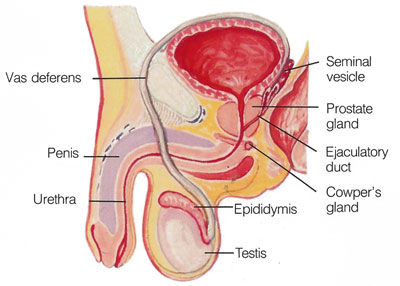

Sperm is very delicate and susceptible to heat, disease, chemicals in food, air, water, and even stress. These environment-based toxins can cause many potential sperm abnormalities: their may not be enough, they may not move well (or at all), they may be abnormally shaped, their genetic code may be abnormal, or the genetic material (DNA) inside the sperm head may be damaged.
Perhaps because reproduction favors the “survival of the fittest,” sperm are not particularly hardy and do not do very well on their trek from the testes (where they are made) to the outside. Even in very fertile men, it is unusual for more than 20% to still have a normal shape after two months in the testes and another two weeks making their way to the outside. In fact, if 14% or more sperm are normal in a sample, it is considered to have normal fertility potential.
Additionally, since sperm only live so long, many die in the testes before the race even begins. This makes the constant creation of healthy, normally functioning sperm, spermatogenesis, a key factor in positive male fertility. Not only does the body need to produce healthy sperm, it needs to produce a lot of it. It takes hundreds of thousands of healthy, functioning sperm to be able to trek to the egg, yet only one will make it for fertilization.
The first step in treating infertility is to test the sperm using an advanced screening process called SCSA (Sperm Chromatin Structure Assay). This innovative test can provide couples with some elusive answers regarding their fertility challenges. An SCSA test can identify the sperm quality as the issue, or rule it out altogether.
When a problem with the sperm is detected, the next step is to search for the cause.
Research over the past several years have provided an explanation for toxins affect the sperm and what might be done to avoid or treat their negative effects. Each cell in the body is a bit like a factory — it takes in raw materials, like carbohydrates, fats, proteins, and vitamins and uses them to create the necessary products and processes. Just like a factory though, each cell also produces waste products, and they can damage the cell if not disposed of properly.
One of the most important of these potentially dangerous, even lethal, waste products is generated during the production of the energy needed by a cell (“oxidation”) and, as a group, is called reactive oxygen species (ROS) or “free radicals.” Free radicals are able to damage the outer layers of a cell, the essential structures inside the cell and even the genetic material (DNA) in the nucleus of a cell.
Unlike virtually every other cell in the body, sperm cells have no defense mechanism. Any toxin that damages a cell will cause it to generate high levels of free radicals that can damage surrounding cells as well.
As more is becoming known about the effects of the environment on sperm quality, many patients want to know how to “fix” this problem.
Treatment may include taking supplemental antioxidants, and improved healthy lifestyle, varicocele repair, avoidance of hot tubs and not using a laptop computer on their lap. Of course, an ounce of prevention is worth a pound of cure. It is important to avoid exposure to some of the common work and environmental toxins like: Organic solvents, oil products, processed foods, chlorinated and fluorinated water, paint, photographic supplies, irradiation, heat, combustion engine exhaust fumes, heavy metals, smoking and drinking, hot baths/frequent Jacuzzi visits, recreational drugs, combined heavy smoking and drinking.
Some of the common drug therapies that cause sperm damage are: Antibiotics, Immune suppressants, Modulators of heart or lipid metabolism, Cancer history and oncology treatment (entire life). It should be noted that medication history for the 10 weeks prior to providing a semen sample can have a negative effect on the quality of the sperm.
With all the risk factors that can damage sperm, and the built-in obstacles even healthy sperm have to face, it’s no wonder men have just as much responsibility in unsuccessful attempts at conception as do women.

